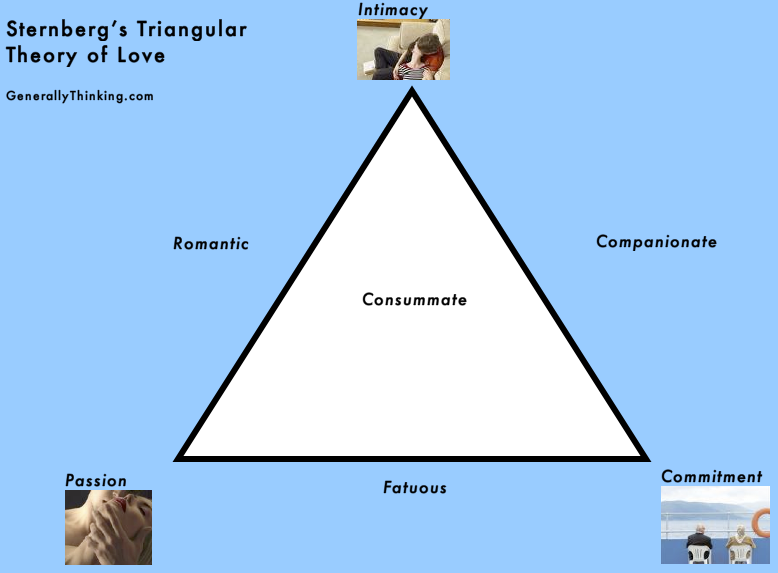Bob Sternberg is a pretty prolific guy in psychology. Among many other topics, he’s studied intelligence, thinking styles, leadership, and he currently holds 10 honorary doctorates. Below I present a quick overview of Sternberg’s triangular theory of love.
In Sternberg’s theory, there are three main facets of love:
- Passion – this includes sexual excitement, feelings of euphoria, infatuation, and physiological arousal generally.
- Intimacy – includes closeness, feeling loved, shared disclosure, empathy, support and sharing.
- Commitment –wanting to be with the other person, being loyal, long-term relationships.
With passion, there is the initial infatuation, the strong emotions, and the attraction. With intimacy, the lovers become closer, inter-dependant, and psychologically their self-concepts begin to overlap. Commitment is the most volitional of the three, the decision to take steps to maintain the love and the relationship.
There are actually eight types of relationships that the model loosely predicts. You can have none, any one, any two, or all three of the presented aspects in a relationship. I drew a diagram below to illustrate. I had visions of this being a glorious and beautiful feat of graphic designery, but it ended up looking like it had been thrown together in 20 minutes using Microsoft Word. Mainly because I did, in fact, throw it together in about 20 minutes using Microsoft Word:

- No aspects = Nonlove
- Intimacy + Passion = Romantic love
- Intimacy + Commitment = Companionate love
- Passion + Commitment = Fatuous love
- Intimacy + Passion + Commitment = Consummate love
So in romantic love you’ve got the passion, and the sharing and caring stuff, but the long-term commitment is not there. I can imagine this can be a frustrating situation. In companionate love, you’re in it for the long haul, and you’re each others’ best friend, but the lust isn’t there. Fatuous love sounds pretty good, if perhaps less stable; the heat is there, and so is the long-term commitment to make the relationship last, but you do without all the lovey-dovey-yucky-disney stuff. And consummate love is the crem-de-la-crem, the combination of all three aspects.
It’s an interesting model. Do you recognise any of your current or past relationships in it? Or those of anyone you know? It is tempting to suggest that nowadays, younger people appear to be mistaking romantic love for one of the other combinations which involve commitment. Tomorrow we’ll look at love in more depth, but right now I have the strangest urge to listen to my “Best of Power Ballads” double album…
Recommended Reading:
Reference:
Sternberg, R. J. (1986). A triangular theory of love. Psychological Review, 93, 119-135.